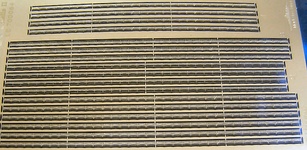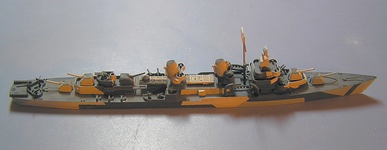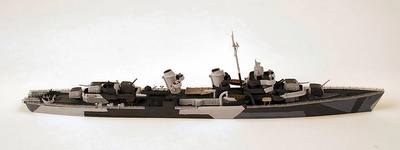 |
| Lion Roar |
|
1/700 WWII US Navy Vessels Guard Rails II with Protective Net |
| Stock Number: LE700064 |
| Reviewed By Luke R. Bucci, IPMS# 33549 |

|
MSRP: $12.00 Web Site: http://www.dragonmodelsusa.com/dmlusa/welcome.asp Bottom Line: Protective netting railing for US Navy destroyers. Very hard to find elsewhere. Photoetch Set Review This set is devoted exclusively to WW2 US Navy railing with protective netting, found mostly on later war destroyers. There are no photoetch sets devoted entirely to railings with nets, so this set fills a gap in outfitting US Navy WW2 warships, particularly destroyers, which used this type of railing extensively in 1943 and afterwards. The fret is a thin brass sheet with four types of railings with nets. Version 1 is 5 rows (490 mm or 1125 scale feet) of typical 3-bar net railing with diagonal supports, used most often on US destroyers. Version 2 is 4 rows (380 mm or 872 scale feet) of 2-bar railing with nets but no diagonals. Version 3 is 3 rows (294 mm or 675 scale feet) of typical 3-bar railing with diagonal supports, but with the netting on top, not on the bottom. Before using Version 3, consult references to make sure that particular style of railing was actually used. Some destroyers did have this style of railing, and there is enough to outfit one model. Version 4 is 4 rows (324 mm or 744 scale feet) of slightly curved typical 3-bar railing with diagonal supports for bow sections of destroyers. Versions 1 and 4 are identical and can be used together, giving 1869 scale feet of railing with netting. Since each Fletcher-class destroyer was 370 feet long, that means two destroyers can be fitted out completely with net railing, with spare railings for mistakes. The railings have sagging upper chains, a touch of realism. Instructions show the two locations for this type of railings – fore and aft – on destroyers. These railings were on deck edges and generally not used on superstructures. It is obvious where railings go so no instructions are really needed. I airbrushed both sides of the fret with ModelMaster acrylic Light Gray 5-L. The railings were easy to cut away from the fret without annoying stubs, which is important for getting a flush fit to the deck. I cut my 1/700 scale rails about 1 or 1.5 inches long and piece them together instead of trying to glue down an entire length of railing across the subtle curves of decks. This netted railing was tougher to bend than regular railing, but held its shape well. The railing was easy to work with. I applied Version 1 (2.5 rows or half of Version 1 rails) to an old Skywave Fletcher-class destroyer model built in the 1990s. The Figures show how the model looks before and after adding railing. I kept the railing 5-L in order to better visualize it against the camouflage pattern. Some ships had darker color netting, and some painted the rails with the camouflage pattern behind them. Again, check references to see which style was used for the particular model you want to build. Keep in mind that this particular model was also embellished with new paint, new turrets, and other photoetch details. Summary Depending on the ship and stage of the war, your can fit out at least two US Navy destroyer models. This is a good value in my opinion, since it is very difficult to find railing with nets anywhere in 1/700 scale. The quality is superior, the accuracy good, the pieces are easy to work with and the finished model looks swell (as they said back in '42). Recommended for super detailing and accurizing US Navy destroyers. References: Raven A. Fletcher-Class Destroyers. United States Naval Institute, Annapolis, MD, 1986. |



 |
|
Information, images, and all other items placed electronically on this site are the intellectual property of IPMS/USA ®. |